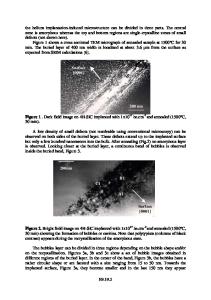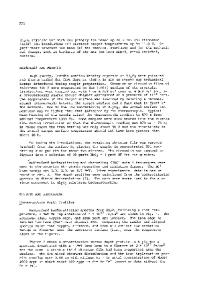Difference in Secondary Defects between High Energy B + and Al + implanted 4H-SiC
- PDF / 332,639 Bytes
- 6 Pages / 595 x 842 pts (A4) Page_size
- 14 Downloads / 250 Views
Difference in Secondary Defects between High Energy B+ and Al+ implanted 4H-SiC Toshiyuki Ohno 1 and Naoto Kobayashi 2 1 Ultra-Low-Loss Power Device Technology Research Body and Advanced Power Devices Laboratory, R&D Association for Future Electron Devices, c/o Electrotechnical Laboratory, 1-1-4 Umezono, Tsukuba, Ibaraki, 305-8568 Japan 2 Ultra-Low-Loss Power Device Technology Research Body and Electrotechnical Laboratory, 1-1-4 Umezono, Tsukuba, Ibaraki, 305-8568 Japan ABSTRACT The differences of secondary defects between B+ and Al+ implanted layers in high-energy implantation were investigated. At the same volume concentration of implanted ion, density of secondary defects in Al+ implanted layer is higher than that in B+ implanted layer. On the contrary, mean defect size in B+ implanted layer is larger than that in Al+ implanted layer. The structure of secondary defect is thought to be a dislocation loop formed by an extra Si-C layer or localized lattice strain correlated to agglomerated interstitials. The amount of interstitials used for secondary defect formation is estimated. It almost coincides the same amount of implanted ions, and this correlation doesn’t depend on ion species. B+ and Al+ implanted layers have different activation energy for secondary defect formation. This result means that they have different agglomerating mechanism of interstitials, which cause the differences of defect size and density between them. INTRODUCTION The fabrication of planar electronic devices requires selective doping and it can be achieved only by ion implantation in SiC because of the small diffusion coefficients of dopants in it. Deep pn junction of several microns with high blocking voltage and low leakage current is necessary to fabricate vertical type high-power devices such as metal-oxide-semiconductor field-effect transistor and junction field-effect transistor [1], and for this purpose, mega-electron-volt energy p-type ion implantation process is indispensable. Generally, B+ or Al+ is used for p-type ion implantation and both B+ and Al+ ions have advantages and disadvantages, each other. For example, B+ implanted pn junction has higher breakdown voltage than Al+ implanted one [2], but the enhanced diffusion of B causes the difficulty of controlling device structure [3]. So selection of ion species is an important theme for p type ion implantation. After implantation, implanted dopants predominantly occupy interstitial lattice sites, where they are usually not electrically active. Therefore, a thermal annealing process is necessary to electrically activate the implanted dopants and to reduce the lattice damage. Transmission Electron Microscope (TEM) observations show that secondary defects are formed during annealing and they are remained after annealing. These defects are dislocation loops having diameter of several nano-meters [4, 5]. These secondary defects may affect the properties of pn junction. But the correlation between secondary defects and implanted ion species is not clear. In this article, we describe t
Data Loading...







